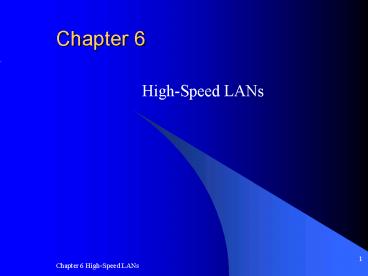HighSpeed LANs - PowerPoint PPT Presentation
1 / 35
Title: HighSpeed LANs
1
Chapter 6
- High-Speed LANs
2
Introduction
- Fast Ethernet and Gigabit Ethernet
- Fibre Channel
- High-speed Wireless LANs
3
Table 6.1
4
Emergence of High-Speed LANs
- 2 Significant trends
- Computing power of PCs continues to grow rapidly
- Network computing
- Examples of requirements
- Centralized server farms
- Power workgroups
- High-speed local backbone
5
Classical Ethernet
- Bus topology LAN
- 10 Mbps
- CSMA/CD medium access control protocol
- 2 problems
- A transmission from any station can be received
by all stations - How to regulate transmission
6
Solution to First Problem
- Data transmitted in blocks called frames
- User data
- Frame header containing unique address of
destination station
7
Figure 6.1
8
CSMA/CD
- Carrier Sense Multiple Access/ Carrier Detection
- If the medium is idle, transmit.
- If the medium is busy, continue to listen until
the channel is idle, then transmit immediately. - If a collision is detected during transmission,
immediately cease transmitting. - After a collision, wait a random amount of time,
then attempt to transmit again (repeat from step
1).
9
Figure 6.2
10
Figure 6.3
11
Medium Options at 10Mbps
- ltdata rategt ltsignaling methodgt ltmax lengthgt
- 10Base5
- 10 Mbps
- 50-ohm coaxial cable bus
- Maximum segment length 500 meters
- 10Base-T
- Twisted pair, maximum length 100 meters
- Star topology (hub or multipoint repeater at
central point)
12
Figure 6.4
13
Hubs and Switches
- Hub
- Transmission from a station received by central
hub and retransmitted on all outgoing lines - Only one transmission at a time
- Layer 2 Switch
- Incoming frame switched to one outgoing line
- Many transmissions at same time
14
Figure 6.5
15
- Bridge
- Frame handling done in software
- Analyze and forward one frame at a time
- Store-and-forward
- Layer 2 Switch
- Frame handling done in hardware
- Multiple data paths and can handle multiple
frames at a time - Can do cut-through
16
Layer 2 Switches
- Flat address space
- Broadcast storm
- Only one path between any 2 devices
- Solution 1 subnetworks connected by routers
- Solution 2 layer 3 switching, packet-forwarding
logic in hardware
17
Figure 6.6
18
Figure 6.7
19
Figure 6.8
20
Figure 6.9
21
Figure 6.10
22
Figure 6.11
23
Benefits of 10 Gbps Ethernet over ATM
- No expensive, bandwidth consuming conversion
between Ethernet packets and ATM cells - Network is Ethernet, end to end
- IP plus Ethernet offers QoS and traffic policing
capabilities approach that of ATM - Wide variety of standard optical interfaces for
10 Gbps Ethernet
24
Fibre Channel
- 2 methods of communication with processor
- I/O channel
- Network communications
- Fibre channel combines both
- Simplicity and speed of channel communications
- Flexibility and interconnectivity of network
communications
25
Figure 6.12
26
I/O channel
- Hardware based, high-speed, short distance
- Direct point-to-point or multipoint
communications link - Data type qualifiers for routing payload
- Link-level constructs for individual I/O
operations - Protocol specific specifications to support e.g.
SCSI
27
Fibre Channel Network-Oriented Facilities
- Full multiplexing between multiple destinations
- Peer-to-peer connectivity between any pair of
ports - Internetworking with other connection technologies
28
Fibre Channel Requirements
- Full duplex links with 2 fibres/link
- 100 Mbps 800 Mbps
- Distances up to 10 km
- Small connectors
- high-capacity
- Greater connectivity than existing multidrop
channels - Broad availability
- Support for multiple cost/performance levels
- Support for multiple existing interface command
sets
29
Figure 6.13
30
Fibre Channel Protocol Architecture
- FC-0 Physical Media
- FC-1 Transmission Protocol
- FC-2 Framing Protocol
- FC-3 Common Services
- FC-4 Mapping
31
Wireless LAN Requirements
- Throughput
- Number of nodes
- Connection to backbone
- Service area
- Battery power consumption
- Transmission robustness and security
- Collocated network operation
- License-free operation
- Handoff/roaming
- Dynamic configuration
32
Figure 6.14
33
IEEE 802.11 Services
- Association
- Reassociation
- Disassociation
- Authentication
- Privacy
34
Figure 6.15
35
Figure 6.16































